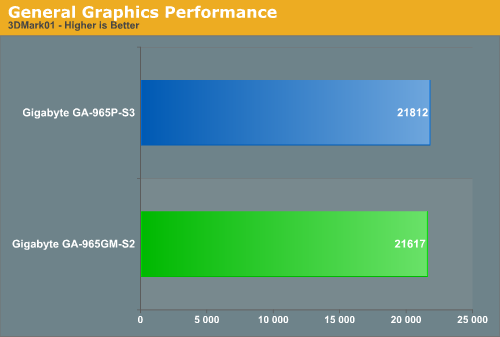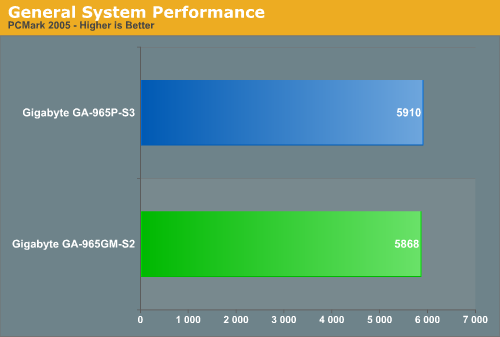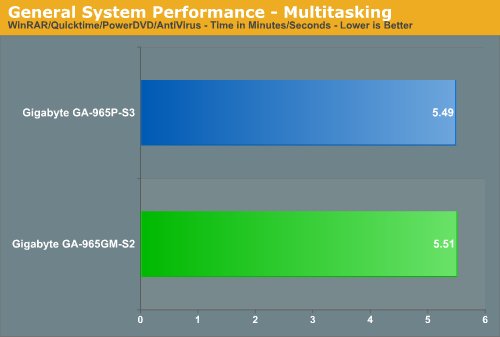Synthetic Graphics Performance
The 3DMark series of benchmarks developed and provided by Futuremark are among the most widely used tools for benchmark reporting and comparisons. Although the benchmarks are very useful for providing apple to apple comparisons across a broad array of GPU and CPU configurations they are not a substitute for actual application and gaming benchmarks. In this sense we consider the 3DMark benchmarks to be purely synthetic in nature but still valuable for providing consistent measurements of performance.


In our GPU intensive 3DMark06 test, each platform score is basically the same although we see the G965 board finishing slightly ahead which indicates there is not a noticeable performance penalty for using a discreet GPU solution on this particular integrated graphics platform. Our G965 board also offered the best CPU performance in this benchmark.
In the more memory and CPU sensitive 3DMark01 benchmark we see P965 board topping the G965 board. We have generally found that the Sandra unbuffered memory bandwidth results will correlate with benchmarks that are memory sensitive. After equalizing the memory sub-timings we consistently had a 90 point difference between the two boards over five different test runs. Either way, the difference is still less than 1%.
General System Performance
The PCMark05 benchmark developed and provided by Futuremark was designed for determining overall system performance for the typical home computing user. This tool provides both system and component level benchmarking results utilizing subsets of real world applications or programs. This benchmark is useful for providing comparative results across a broad array of Graphics, CPU, Hard Disk, and Memory configurations along with multithreading results. In this sense we consider the PCMark benchmark to be both synthetic and real world in nature and it provides consistency in our benchmark results.

The P965 board once again tops the chart although the margin remains slim. Both boards basically tied each other in the individual tests with the P965 board performing slightly better in the multitasking tests.
Multitasking Performance
We devised a script that would compress our standard test folder consisting of 444 files, ten subfolders, and 602MB worth of data, convert a 137MB High Definition QuickTime movie clip to a 37MB MPEG-4 format, play back the first two chapters of Office Space with PowerDVD, and run our AVG anti-virus program in the background. We stop the script when the file compression and video conversion are complete. This is a very taxing script for the CPU, Memory, and Storage subsystem. We also find this to be a good indicator of system stability during our overclocking testing.

The performance difference basically mirrors our other tests with the P965 board finishing first due to great CPU/disk performance during the AVG virus scan. Although our video conversion and playback never stuttered during testing on the G965 board we did see pauses in the AVG scanning and the number of files scanned was about two percent less at the end of the test. However, the differences in scores is absolutely minimal and only something a benchmark would detect.
The 3DMark series of benchmarks developed and provided by Futuremark are among the most widely used tools for benchmark reporting and comparisons. Although the benchmarks are very useful for providing apple to apple comparisons across a broad array of GPU and CPU configurations they are not a substitute for actual application and gaming benchmarks. In this sense we consider the 3DMark benchmarks to be purely synthetic in nature but still valuable for providing consistent measurements of performance.


In our GPU intensive 3DMark06 test, each platform score is basically the same although we see the G965 board finishing slightly ahead which indicates there is not a noticeable performance penalty for using a discreet GPU solution on this particular integrated graphics platform. Our G965 board also offered the best CPU performance in this benchmark.
In the more memory and CPU sensitive 3DMark01 benchmark we see P965 board topping the G965 board. We have generally found that the Sandra unbuffered memory bandwidth results will correlate with benchmarks that are memory sensitive. After equalizing the memory sub-timings we consistently had a 90 point difference between the two boards over five different test runs. Either way, the difference is still less than 1%.
General System Performance
The PCMark05 benchmark developed and provided by Futuremark was designed for determining overall system performance for the typical home computing user. This tool provides both system and component level benchmarking results utilizing subsets of real world applications or programs. This benchmark is useful for providing comparative results across a broad array of Graphics, CPU, Hard Disk, and Memory configurations along with multithreading results. In this sense we consider the PCMark benchmark to be both synthetic and real world in nature and it provides consistency in our benchmark results.

The P965 board once again tops the chart although the margin remains slim. Both boards basically tied each other in the individual tests with the P965 board performing slightly better in the multitasking tests.
Multitasking Performance
We devised a script that would compress our standard test folder consisting of 444 files, ten subfolders, and 602MB worth of data, convert a 137MB High Definition QuickTime movie clip to a 37MB MPEG-4 format, play back the first two chapters of Office Space with PowerDVD, and run our AVG anti-virus program in the background. We stop the script when the file compression and video conversion are complete. This is a very taxing script for the CPU, Memory, and Storage subsystem. We also find this to be a good indicator of system stability during our overclocking testing.

The performance difference basically mirrors our other tests with the P965 board finishing first due to great CPU/disk performance during the AVG virus scan. Although our video conversion and playback never stuttered during testing on the G965 board we did see pauses in the AVG scanning and the number of files scanned was about two percent less at the end of the test. However, the differences in scores is absolutely minimal and only something a benchmark would detect.










8 Comments
View All Comments
8steve8 - Tuesday, March 20, 2007 - link
nice to look at the g965, long overdue.but u didnt even touch on integrated graphics.
lots of people out there dont play many 3d games.
you should have compared performance between g965 onboard with g965 discrete with p965 discrete
power/heat numbers would be interesting, then we could see how efficient the integrated x3000 is...
xsilver - Saturday, March 17, 2007 - link
are there ANY G965 boards that DO overclock well?JarredWalton - Saturday, March 17, 2007 - link
Meaning beyond 325MHz bus speeds? No, because the X3000 IGP really limits the chipset's maximum speed. Where on the P965 you're able to overclock the chipset to 500 MHz and above, the IGP can really only take about a 25% overclock - certainly not more than 33% or so. You might be able to hit 350 MHz on some boards, but that's about it as far as I'm aware. Other IGP chipsets on the other hand... we'll have to see Gary's mATX roundup for that information.Treripica - Saturday, March 17, 2007 - link
I'd like to echo MrNeutrino's sentiment. How massive of a mATX roundup can we look forward to in the near future?kobymu - Saturday, March 17, 2007 - link
I just wanted to say thanks for saying that.
While enthusiast discussion is important (I'm PC enthusiast myself), it is always more important to keep a wider, proportional point of view of the industry as a whole, and that sentence has achieved that goal, so when the enthusiasts start discussing higher-end PC components it can take a more practical, sensible approach, and maybe, hopefully, with time we will see a decrease in the "OMG company X is going down!11" department in particular and in radical fanboism in general.
sdsdv10 - Saturday, March 17, 2007 - link
Do you really expect enthusiasts to be either practial or sensible...
That would be kind of an oxy-moron!
MrNeutrino - Saturday, March 17, 2007 - link
Thanks for taking the time to post the mATX performance update, Gary!My performance concerns based on architectural scrutiny of how memory bandwidth is shared between two hungry processors in an IGP chipset vs. its ATX counterpart, were always nagging me as I started looking for a mATX build. Add to that the lack of always reliable reviews - if at all - on the web, and you have the perfect recipe for a burning desire to be sure - and soon - whether almost a thousand some odd dollars of investment in a quality mATX vs. ATX (read: G965 vs. P965) will be worth the money.
At least in my case, the lingering questions were mostly extinguished by your forum reply with quantifiable benchmark data, after the 690G review. What little concern remained (more like intrigue), has been put to rest with these benchmarks and additional comparison data in this article.
Impressive, that there is this little difference between the two chipset / system architecture variants. I suppose then, thanks goes in large part to the hunk of cache on the C2D (compared to CPUs of just a few years back), better predictors / prefetchers, shorter pipelines and a myriad of other uArch improvements.
Anyway, techincal topics aside, all I can say is, HURRAY!!
I'm just happy that this is concrete, published proof that us SFF / mATX fans can have our cake and eat it too!
Now if only we all could also get those April C2D price drops soon enough... :)
Renoir - Saturday, March 17, 2007 - link
Agreed this was a good comparison of the performance between G965 and P965 when BOTH are using a discrete card. As for the question of how sharing memory bandwidth between IGP and CPU compares to using a discrete card, it has only been touched upon briefly by Gary in the forum thread you mentioned. More detailed info on this aspect would be much appreciated in the upcoming roundup (already planned?). Bit-Tech.net did just that with the 690G but they used XP so I'm very interested in the results when using the more bandwidth hungry Aero in Vista.